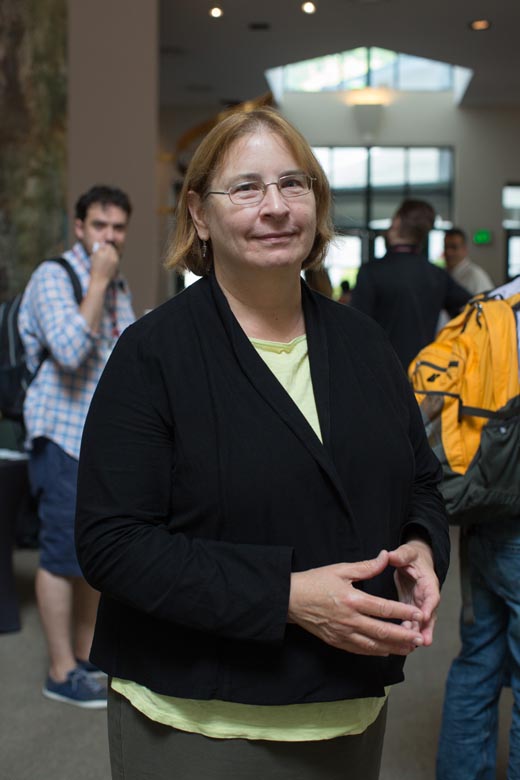Last weekend, we hosted the third CSHL meeting on Genome Engineering: The CRISPR/Cas Revolution. We met with Maria Jasin, one of the three original organizers and a CSHL meeting veteran, to talk about the CRISPR meeting. Here is a quick overview of her research:
We study double strand break repair and genomic instability, with a particular interest in the breast cancer suppressors BRCA1 and BRCA2. We’ve also had a major interest in understanding meiotic recombination and how double strand breaks are repaired there, and maybe aberrantly repaired in other syndromes.
Maria provided a great overview of the meeting, how it has evolved with the field, and the developments she’s most excited about.
One major change is the expansion in the number of enzymes and nucleases that are being used. The first meeting focused primarily on Cas9 itself. Now, many different enzymes are used that have better applications than Cas9 in some contexts, which is an exciting development in the field that is much more represented in the meeting than it was in the past. It’s a recognition of how large the CRISPR repertoire is in bacteria, the almost limitless number of proteins that can be cloned and characterized, that have somewhat different specificities or other reasons that make them preferable in different situations.
This year’s meeting started with a lot of CRISPR biology which I found really exciting, because it lets us non-CRISPR biologists understand this beautiful genetic system of adaptive immunity in bacteria. Also, there’s been an emergence of anti-CRISPRs - peptides that can halt CRISPR activity. These peptides are numerous and act differently by blocking different steps, which is a really fascinating system. It’s perhaps not surprising that there are some practical uses to them as well.
One of the really exciting things for me was Kathy Niakan’s talk about using human zygotes to address important questions about embryonic development in humans. Obviously, it’s a very difficult system that needs to be heavily regulated. But as much as we know about mouse development and the very earliest stages of mouse embryos, one thing that’s clear is how different things are in human embryos. We have known for a long time that human oocytes are very prone to aneuploidy, and that results in miscarriages or birth defects. Trying to understand the genome instability that arises in the early stages of embryos is something that’s also important for human health and infertility.
Another talk I was excited about was given by Danwei Huangfu, who uses human pluripotent stem cells to understand pancreatic development. For a long time, we’ve only been able to use cell lines in humans that are transformed and highly aberrant. The ability to use cells that can be differentiated into human lineages is really exciting and highlights the ability to understand, again, human embryonic development at a much later stage. It’s related to human genetics that in the past we wouldn’t have been able to do.
Also, my student, Weiran Feng gave a talk about his work on homologous recombination – one of the pathways people like to use to modify the genome. It was very touching for me to see one of my students develop a beautiful story and present it in a beautiful way.
These days, there’s no shortage of scientific meetings focused on CRISPR. We asked Maria what sets the CSHL meeting apart from others, and also who benefits most from attending it.
There certainly has been a large explosion of CRISPR and genome engineering meetings, but the one thing that’s particularly exciting about this meeting is its emphasis on biology. We, of course, have talks that are more technical, about improving the CRISPR systems or adapting new systems or doing screens. But we’ve balanced it by having a lot of biologists present who are trying to understand human development. We even had a talk this year on using killifish as a new model for aging, so the meeting brings together a lot of biologists.
Commercial interest companies love this meeting because they are able to showcase their work here. Most of the talks are from academic scientists though, who love this meeting for the basic biology and technology developments that are coming from and presented by academic labs.
And Cold Spring Harbor is always a great place for graduate students and postdocs. We do have invited speakers, but the number of talks given by postdocs or grad students outnumber the invited talks. My first talk as a scientist was at CSH when I was a graduate student! Attending a Cold Spring Harbor meeting is an ideal way to start your career because you are able to not only interact with a number of scientists but also have the opportunity to speak or present a poster.
We ended the conversation on how this year’s meeting turned out.
I had thought that, with time, the meeting would get less exciting but this year’s meeting was just as exciting as the first one. It’s a testament to the growth of the field, the creative approaches people are taking, and the expansion of the number of nucleases involved. We brought in people with different expertise – stem cells, modifying human embryonic cells, etc. – which brought together people who don’t know or often see other. The meeting hits a lot of different areas in biology even if there’s a CRISPR coherence to it, and that promotes great scientific interactions.
The Genome Engineering: The CRISPR/Cas Revolution meeting will return to campus on August 22-25, 2018. Follow us on Facebook or Twitter for meeting updates.
To read more conversations with CSHL meeting organizers and course instructors, browse through our A Word From... series.

